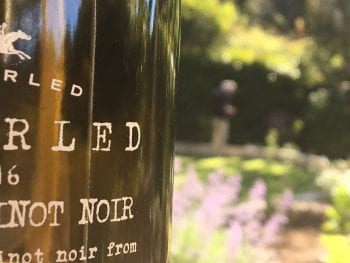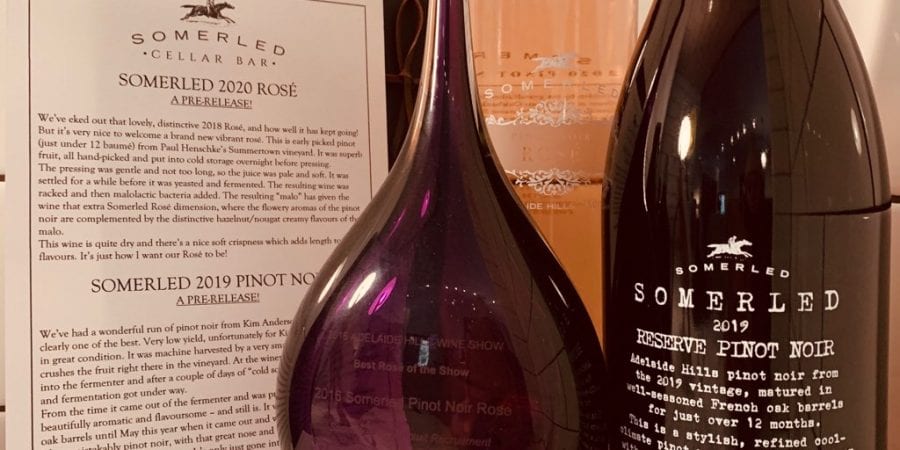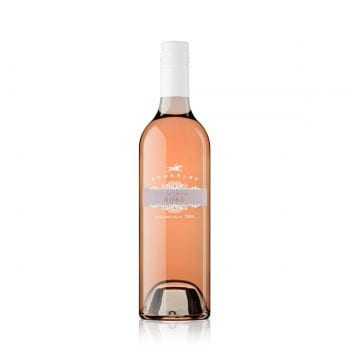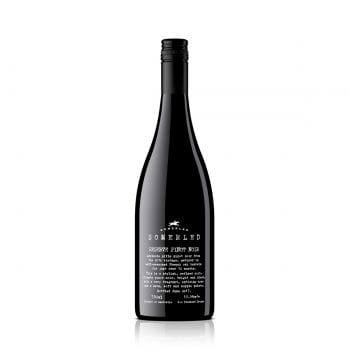Two brand new wines are on their way to our Jockey Club members as we speak. And we’re so excited to be sharing these wines with you all.
I can imagine you might have a few questions for the guy responsible for them. And while I’m not much of a mind reader, I’ve had a go at imagining what some of those questions might be…
So, let’s sit down and have a chat to Rob about the new additions to the Somerled stable!
Tell us a bit about your two new wines Rob…
 2020 Pinot Noir Rosé
2020 Pinot Noir Rosé
The 2020 Rosé is made from early picked pinot from Paul Henschke’s Summertown vineyard. It was superb fruit, all handpicked and put into cold storage overnight before pressing.
The pressing was gentle and not too long, so the juice was pale and soft. It was settled for a while before it was yeasted and fermented. The resulting wine was racked and then malolactic bacteria added. The resulting “malo” has given the wine that extra Somerled Rosé dimension, where the flowery aromas of the pinot noir are complemented by the distinctive hazelnut/nougat creamy flavours of the malo.
This wine is quite dry and there’s a nice soft crispness which adds length to the flavours. It’s just how I want our Rosé to be!
 2019 Pinot Noir Dry Red
2019 Pinot Noir Dry Red
We’ve had a wonderful run of pinot noir from Kim Anderson, and 2019 was clearly one of the best. Very low yield, unfortunately for Kim, but lovely ripe fruit in great condition. It was machine harvested by a very smart machine that gently crushes the fruit right there in the vineyard. At the winery, the pinot went straight into the fermenter and after a couple of days of “cold soaking” yeast was added and fermentation got underway.
From the time it came out of the fermenter and was pressed, this wine has been beautifully aromatic and flavoursome – and still is. It was in nicely mature French oak barrels until May this year when it came out and was prepared for bottling.
It’s unmistakably pinot noir, with that great nose and the soft, warm, gentle palate with flavours that linger for ages. It’s only just gone into bottle, so I’m looking forward to it becoming more and more silky as time goes on.
Why do you like Pinot so much?!
It’s a very recent thing liking pinot noir dry red. Maybe no more than 10-12 years.
My early winemaking career with Penfolds (1969-1977) did not involve pinot in any way, shape or form. This was mainly because there was very little pinot noir around. Also because the delicate aromatic light-coloured nature of pinot was the very antithesis of the famous Penfold dry red style.
There was a stop-start time with pinot at Wynns Coonawarra, but that was largely pinot for sparkling base wine, with only 3 or 4 years with dry red. Is there anyone out there who remembers the Wynns Coonawarra Estate Pinot Noir, with the nice blue label? I think the last one of those was 1987 or thereabouts.
But with age comes enlightenment to a degree! Being more closely involved in the Adelaide Hills since I left the corporate world has made me see what good pinot noir can offer. I just love the subtlety and elegance of pinot noir dry red. And as I’ve often said, I love the character that pinot noir (and pinot meunier) give to sparkling wines. Going back to Wynns days, I clearly remember just how good (and how French) some of the base wines for sparkling were. A lot is said and written about yeastiness in champagne, but to me, a lot of that character comes from the pinot noir along with the climate.
And then there’s Rosé. It seems so right to make Rosé from pinot noir as the variety has such lightness, lovely lifted aromas and not too weighty a palate. It’s the perfect variety for Rosé.
So that’s why I’m quite fond of pinot noir!
Why hasn’t the 2020 Rosé been affected by the bushfires?
Our 2020 Rosé was made from Paul Henschke’s pinot noir from Summertown, and fortunately Paul’s vineyard was away from the direct line of the bushfires. The fruit was in great condition, and not even drought/heat affected.
Remind me, what was vintage 2019 like? Was it good for Pinot?
For winemakers, 2019 was great for Adelaide Hills pinot noir.
But for growers, it was awful, with very low yields everywhere.
Kim produced small amounts of pinot noir that we were lucky enough to get from him and it made absolutely terrific wine. It’s so aromatic and with great length of flavour. The low yields affected just about every variety in 2019, and this seems to have affected all regions right across Australia too. At Kim’s vineyard, the main reasons for the low yields were a combination of an odd frost early in the growing season, and the very cold wet weather during fruit set (Nov/Dec), even with a bit of hail!
I’m pretty familiar with your previous Pinot and Rosé vintages… are these new ones similar?
The new ones are very similar.
Mainly because it’s so young, the 2020 Rosé is pinker than the 2018 that it’s replacing. But it’s very similar in its pale colour, gentle pinot fruit and that typical Somerled Rose malolactic influence.
The 2019 Pinot Noir dry red is very similar to the 2018 – perhaps a little bigger and more intense. The 2018 is a little softer at this stage, but the 2019 will follow suit with a little time.
Have you always made your Rose from Pinot Noir?
The first Rosé was from Paul’s vineyard when he had a generous crop. Since then, it has been from either Paul’s or Kim’s vineyard. With the exception of 2014, when we couldn’t get any pinot noir at all. David Blows came to the rescue with Sangiovese from his vineyard near Macclesfield. That was a very nice rose, but I still think pinot noir is the best.
When should I drink these new wines? Now? Or should I hang onto them for a while?
Rosé is always best young, so the ideal for me is for all the 2020 Rose to be drunk by this time next year, when the 2021 should be just in bottle and ready to go!
The answer is not so simple with the 2019 Pinot Noir.
 We recently drank the last known bottle of our 2010 Pinot Noir, and whilst it drank beautifully, I didn’t see any real improvement in the wine from five years ago. I always see a huge difference between a two-year-old Somerled Shiraz and a ten-year-old, but that sort of change doesn’t seem to show up in our Pinots.
We recently drank the last known bottle of our 2010 Pinot Noir, and whilst it drank beautifully, I didn’t see any real improvement in the wine from five years ago. I always see a huge difference between a two-year-old Somerled Shiraz and a ten-year-old, but that sort of change doesn’t seem to show up in our Pinots.
So I think it’s worth holding for a year or two to allow the wine to settle down and become softer and silkier (it’s only very recently gone into bottle). The rewards don’t seem to be there in holding for many years, but who knows, I may be proven wrong!!
(That sounds like a challenge to me Rob! Anyone keen to hang onto their Pinot for another 10 years or so…….? No, didn’t think so!)
I ordered a couple of bottles of your new Tempranillo 2018 to go with my July pack wines… what should I expect when I open it?
This is a typical Tempranillo. It’s medium-deep in colour with nice developed tints, the nose is very lifted and with that hint of blackberry at the back. The palate is firm but with a flavour that lingers very nicely.
With the time in barrel, it has started to achieve a degree of complexity, but with more to come. With time the palate will become rounder and more supple. It’s very elegant!
And don’t let that word “typical” fool you. While it is very varietal, it is far from your regular tempranillo! Rob’s version has always been something a little special (like all of his wines really!). The only way to find out is to get a bottle (or two) yourself!
Did I get your questions right? If I missed any, send them through in the comments below (or send me an email) and I’ll ask on your behalf!


 2019 Pinot Noir Dry Red
2019 Pinot Noir Dry Red
Very good Maree!!